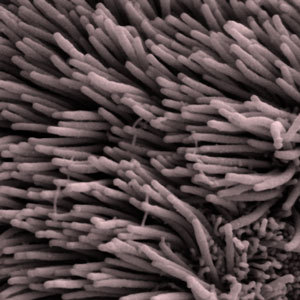
The 'N17' region of huntingtin protein: an address label in Huntington's disease?
New research sheds light on where the huntingtin protein ends up inside our cells, and why
New research is helping understand how the mutant huntingtin protein moves around the cell. Discovering where huntingtin ends up, and why, could help us understand HD. Now, Canadian researchers have shown that a small piece of the huntingtin protein behaves like an ‘address label’ for the whole protein. By studying this label and how it affects Huntington’s disease symptoms, we may be able to better understand what goes wrong in HD and hopefully generate a disease-modifying therapy.
Big things can come from little packages
We know that all problems in Huntington’s disease are due to a mutation or error in the genetic blueprints for making a protein called huntingtin. In those diagnosed or destined to develop the HD, this ‘spelling mistake’ at the beginning of the genetic instructions, causes a particular bit of the protein to be longer than normal. But the functions of the normal protein, and the ways in which the mutant protein causes damage, are still rather mysterious.

When a protein is being made, little building blocks are string together like beads on a string. In someone with the Huntington’s disease mutation, too many building blocks called ‘glutamine’ are added at the beginning of the huntingtin protein.
Scientists call this bit of huntingtin containing the extra glutamines, the N-terminal region. Soon after the Huntington’s disease gene was discovered in 1993, scientists determined that the N-terminal region is the most harmful bit of the huntingtin protein.
Over the past decade, researchers have identified a critical role for an even smaller piece of huntingtin, the first seventeen building blocks known as the N17 region. This region seems important in telling huntingtin where to go and what to interact with.
Studying these features of huntingtin is important because once we understand how the N17 region works, we might be able to develop drugs to alter its behavior and make it less toxic to our precious neurons.
Location, Location, Location!
Recent publications by Prof Ray Truant from McMaster University in Canada, and Marc Diamond of Washington University in St Louis, USA, have examined this particular piece of the huntingtin protein and its potential impact on the disease.
The scientists revealed that the N17 piece of huntingtin appears to function as an ‘address label’ to tell the cell where the huntingtin protein should be delivered.
Where exactly Huntingtin’s final destination in the cell is, plays an important role in the progression of Huntington’s disease. Huntingtin does different things in different places. In some locations, it may be less dangerous than in others. Exactly where huntingtin is found inside cells can have a major impact on the its normal activities and whether or not the cells can deal with the mutant protein.
Previous studies told us that huntingtin can shuttle between various regions of a cell by means of its ‘address label’.
An address for huntingtin
The new research from these two groups has gone into greater depth to determine that the N17 piece of huntingtin resembles something called a nuclear export signal.
A nuclear export signal is a bit of a protein which acts like an ‘address label’ to tell the cell where to deliver a package – in this case the huntingtin protein. The nuclear export signal tells the cell to keep the protein out of the nucleus, where the all-important DNA is kept. Instead, a protein with a nuclear export signal ends up in the cytoplasm, the squishy bit of the cell that surrounds, cushions, and protects all the internal machinery of the cell.
If you think of the cell as a city, the nuclear export signal keeps the package out of the city hall, instead allowing it to float around the open spaces of the city like its public parks.
That’s the story for normal huntingtin protein. What about the mutant protein?
Well, in Huntington’s disease, there appears to be an error in the ‘address label’, causing it to be read incorrectly. In this case, the mutant form of huntingtin does not get shuttled out into the cytoplasm – the public park – but instead remains in the nucleus – the city hall.
This error – allowing the ‘unauthorized’ protein to remain in the nucleus, may contribute to the death of neurons and disease progression. The nucleus is a really important part of the cell – it acts as the a control center of the cell and houses the genetic material.
Lots of research suggests that huntingtin is more toxic to cells when it is in the nucleus. But it can also do harm when it is outside the nucleus, so finding out where and how this package is delivered is important.

How do researchers study something so small?
In order to study how huntingtin is moved throughout the cell, researchers used living cells, grown in small dishes in the lab. They altered the cells genetically so that they only produced the N17 piece of huntingtin. This fragment was joined onto a protein from jellyfish that glows yellow under a microscope.
The attached glowing protein allows scientists to watch the N17 piece as it moves around inside cells. Importantly, it allows researchers to observe where it’s delivered if they make changes or introduce deliberate errors into the ‘address label’.
Who is delivering these packages?
Based on what they knew already from other proteins with nuclear localization signals, the researchers thought that this label on huntingtin may be recognized by a ‘mailman’ protein called CRM1. By studying both proteins at once – the CRM1 mailman and the huntingtin package – they discovered that CRM1 interacts with N17’s address label based on its unique structure and shape.
Through making small changes to the address label, they found that the nuclear localization signal is very precise. It has to have all of the correct information, shape and other properties, in order to be delivered to the correct location in the cell. If for some reason the label is different from normal, the package is delivered to the wrong location. This seems to be what’s happening in Huntington’s disease.
Oh Cilia…
Truant and his team demonstrated that the N17 region also controls whether huntingtin ends up attached to the cell’s cilia – tiny hair-like propellers on the outside of the cell.
Depending on what’s happening to a cell, a protein’s address label can be altered using little chemical tags that get attached or removed. The cell’s transport machinery can then read these tags like a bar code to determine what to do with huntingtin.
The researchers found that when the N17 bit of huntingtin did not have a tag, it remained inside the cilia. When they put a tag on huntingtin, they found that instead, it built up at the base of the cilia.
What’s next?
This new research looks at very tiny events to help us understand an important bigger picture. Research like this helps us understand the signals that move the mutant huntingtin protein around the cell and how this process may be going wrong in HD.
Work carried out in cells like this is a long way from generating treatments that can be used in patients. However, these studies help clarify prior research by different groups with sometimes confusing findings regarding the N17 region of huntingtin.
These results are an important step forward that help us understand how cell damage occurs in Huntington’s disease. They opens a new door for researchers to work on future treatments to try to restore the normal shuttling of huntingtin protein.
Though these seventeen building blocks are just a small portion of the whole huntingtin protein, they can have a huge impact on its location and function – and our understanding of Huntington’s disease.
Learn more
For more information about our disclosure policy see our FAQ…


